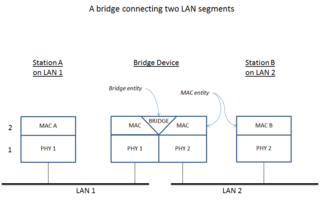A media access control address of a device is a unique identifier assigned to a network interface controller (NIC). For communications within a network segment, it is used as a network address for most IEEE 802 network technologies, including Ethernet, Wi-Fi, and Bluetooth. Within the Open Systems Interconnection (OSI) model, MAC addresses are used in the medium access control protocol sublayer of the data link layer. As typically represented, MAC addresses are recognizable as six groups of two hexadecimal digits, separated by hyphens, colons, or no separator.

Network topology is the arrangement of the elements of a communication network. Network topology can be used to define or describe the arrangement of various types of telecommunication networks, including command and control radio networks, industrial fieldbusses, and computer networks.
The Spanning Tree Protocol (STP) is a network protocol that builds a loop-free logical topology for Ethernet networks. The basic function of STP is to prevent bridge loops and the broadcast radiation that results from them. Spanning tree also allows a network design to include backup links to provide fault tolerance if an active link fails.
A virtual LAN (VLAN) is any broadcast domain that is partitioned and isolated in a computer network at the data link layer. LAN is the abbreviation for local area network and in this context virtual refers to a physical object recreated and altered by additional logic. VLANs work by applying tags to network frames and handling these tags in networking systems – creating the appearance and functionality of network traffic that is physically on a single network but acts as if it is split between separate networks. In this way, VLANs can keep network applications separate despite being connected to the same physical network, and without requiring multiple sets of cabling and networking devices to be deployed.

In IEEE 802 LAN/MAN standards, the medium access control (MAC) sublayer and the logical link control (LLC) sublayer together make up the data link layer. Within that data link layer, the LLC provides flow control and multiplexing for the logical link, while the MAC provides flow control and multiplexing for the transmission medium.

A network interface controller is a computer hardware component that connects a computer to a computer network.
Cisco Discovery Protocol (CDP) is a proprietary Data Link Layer protocol developed by Cisco Systems. It is used to share information about other directly connected Cisco equipment, such as the operating system version and IP address. CDP can also be used for On-Demand Routing, which is a method of including routing information in CDP announcements so that dynamic routing protocols do not need to be used in simple networks.

EtherChannel is a port link aggregation technology or port-channel architecture used primarily on Cisco switches. It allows grouping of several physical Ethernet links to create one logical Ethernet link for the purpose of providing fault-tolerance and high-speed links between switches, routers and servers. An EtherChannel can be created from between two and eight active Fast, Gigabit or 10-Gigabit Ethernet ports, with an additional one to eight inactive (failover) ports which become active as the other active ports fail. EtherChannel is primarily used in the backbone network, but can also be used to connect end user machines.

Ethernet flow control is a mechanism for temporarily stopping the transmission of data on Ethernet family computer networks. The goal of this mechanism is to ensure zero packet loss in the presence of network congestion.

A network bridge is a computer networking device that creates a single aggregate network from multiple communication networks or network segments. This function is called network bridging. Bridging is distinct from routing. Routing allows multiple networks to communicate independently and yet remain separate, whereas bridging connects two separate networks as if they were a single network. In the OSI model, bridging is performed in the data link layer. If one or more segments of the bridged network are wireless, the device is known as a wireless bridge.

A computer network is a digital telecommunications network which allows nodes to share resources. In computer networks, computing devices exchange data with each other using connections between nodes. These data links are established over cable media such as wires or optic cables, or wireless media such as Wi-Fi.
Port Aggregation Protocol (PAgP) is a Cisco Systems proprietary networking protocol, which is used for the automated, logical aggregation of Ethernet switch ports, known as an EtherChannel. The PAgP is proprietary to Cisco Systems. A similar protocol known as LACP — released by the IEEE and known as 802.3ad or 802.1ax recently — is an industry standard and is not tied to a specific vendor:
PME Aggregation Function (PAF) is a computer networking mechanism defined in Clause 61 of the IEEE 802.3 standard, which allows one or more Physical Medium Entities (PMEs) to be combined together to form a single logical Ethernet link.

Multi-link trunking (MLT) is a link aggregation port trunking technology developed at Nortel in 1999. It allows grouping several physical Ethernet links into one logical Ethernet link to provide fault-tolerance and high-speed links between routers, switches, and servers. US patent 6731599, Van Hunter, Joseph Regan, Alfred Nothaft, Akhil Duggal; Regan, Joseph & Nothaft, Alfred et al., "Automatic Load Sharing-Trunking", issued 2004-05-04, assigned to Nortel Networks Limited and Avaya Holdings Limited
MC-LAG, or Multi-Chassis Link Aggregation Group, is a type of link aggregation group (LAG) with constituent ports that terminate on separate chassis, primarily for the purpose of providing redundancy in the event one of the chassis fails. The IEEE 802.1AX-2008 industry standard for link aggregation does not mention MC-LAG, but does not preclude it. Its implementation varies by vendor; notably, the protocol existing between the chassis is proprietary.

Open vSwitch, sometimes abbreviated as OVS, is an open-source implementation of a distributed virtual multilayer switch. The main purpose of Open vSwitch is to provide a switching stack for hardware virtualization environments, while supporting multiple protocols and standards used in computer networks.













